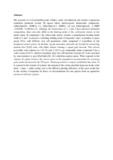Please use this identifier to cite or link to this item:
https://cris.library.msu.ac.zw//handle/11408/2935Full metadata record
| DC Field | Value | Language |
|---|---|---|
| dc.contributor.author | Mehlana, Gift | en_US |
| dc.contributor.author | Wilkinson, Chad | en_US |
| dc.contributor.author | Dzesse T., Christelle N. | en_US |
| dc.contributor.author | Ramon, Gaelle | en_US |
| dc.contributor.author | Bourne, Susan A. | en_US |
| dc.date.accessioned | 2017-11-02T17:14:55Z | - |
| dc.date.available | 2017-11-02T17:14:55Z | - |
| dc.date.issued | 2017 | - |
| dc.identifier.uri | http://pubs.acs.org/doi/abs/10.1021/acs.cgd.7b01101 | - |
| dc.identifier.uri | http://hdl.handle.net/11408/2935 | - |
| dc.description.abstract | The reaction of 3-(4-pyridyl)benzoate (34pbz) under solvothermal and solvent evaporation conditions produced several 2D square lattice metal-organic frameworks compounds, {[Zn(34pbz)2] .·DMF}n (1), {[Zn(34pbz)2.] .·DMF}n (2) and {[Zn(34pbz)2] .·2 DMF .·CH3OH·. ½ H2O}n (3). Although the frameworks of 1, 2 and 3 have identical elemental composition, these networks differ in the binding mode of the carboxylate moiety to the metal center. In compound 1 the carboxylate moiety assumes a monodentate binding mode while in 2 and 3 it assumes a chelating binding mode. Compound 1 and 3 crystallize in space group P21/c with different unit cell parameters while compound 2 crystallizes in the tetragonal crystal system. In all three crystal structures, networks are formed by connecting mononuclear Zn(II) units with 34pbz linkers forming a square grid network. The solvent accessible void volumes in 1 (21 %) and 2 (18 %) are comparable while compound 3 has a void volume of 42 %, which is extremely large for a 2D network. Crystals of 2 were activated by heat treatment to give [Zn(34pbz)2]n (2d) which has narrow pores. When exposed to the vapours of xylene isomers, the narrow pores in 2d expanded to accommodate the incoming guest molecules between the 2D layers. Thermogravimetric analysis established that when 2d is exposed to the isomers of xylenes, the amount of the xylene adsorbed increases in the order meta- < para- < ortho-xylene, due to the different packing efficiency of the guest molecules in the cavities. Compound 2d shows no discrimination for one species from an equimolar mixture of all three xylenes. | en_US |
| dc.language.iso | en | en_US |
| dc.publisher | American Chemical Society | en_US |
| dc.relation.ispartofseries | Crystal Growth & Design; | - |
| dc.subject | Metal organic frameworks | en_US |
| dc.subject | Carboxylate moiety | en_US |
| dc.title | Structural diversity observed in 2D square lattice metal-organic frameworks assembled from Zn(II) and 3-(4-pyridyl)benzoate | en_US |
| dc.type | research article | en_US |
| item.fulltext | With Fulltext | - |
| item.openairetype | research article | - |
| item.languageiso639-1 | en | - |
| item.cerifentitytype | Publications | - |
| item.grantfulltext | open | - |
| item.openairecristype | http://purl.org/coar/resource_type/c_18cf | - |
| Appears in Collections: | Research Papers | |
Files in This Item:
| File | Description | Size | Format | |
|---|---|---|---|---|
| Abstract.pdf | Abstract | 5.74 kB | Adobe PDF |  View/Open |
Items in MSUIR are protected by copyright, with all rights reserved, unless otherwise indicated.


